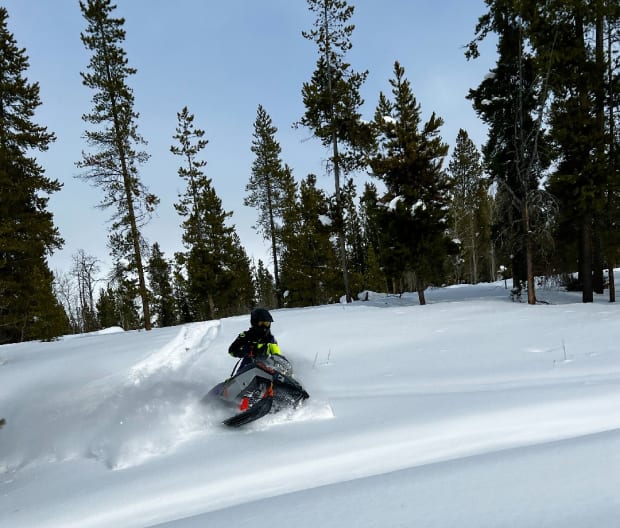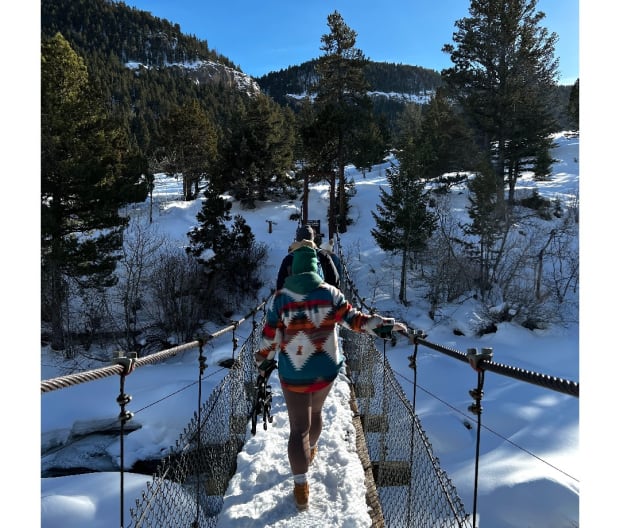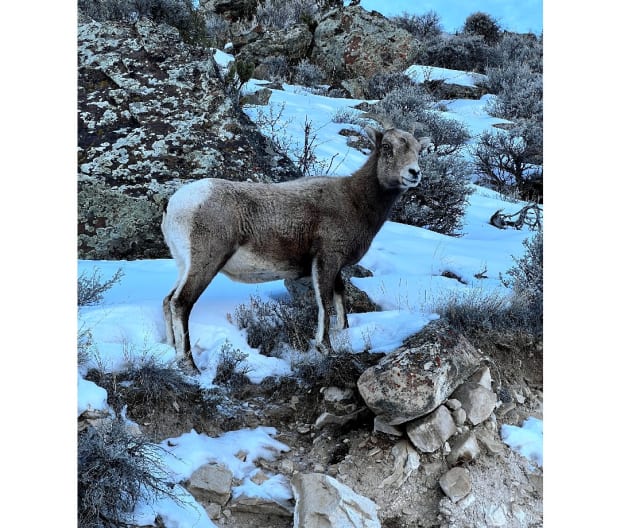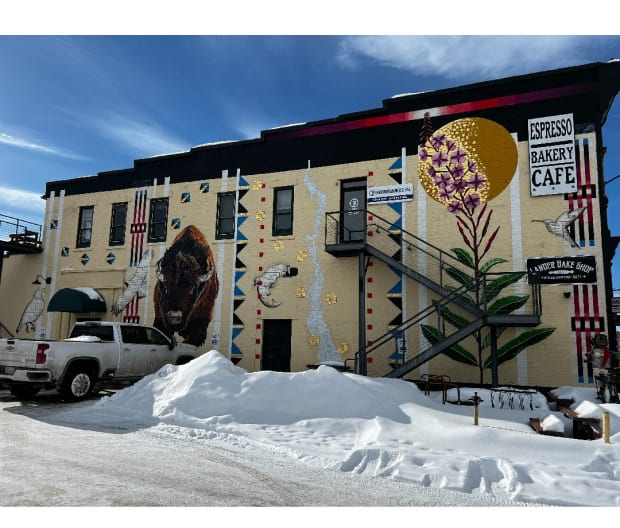For winter fun and solitude way off the beaten trail, Wyoming’s remote Wind River Range can’t be beat.
Cool, dry mountain air whips by as my snowmobile approaches 40 miles per hour. Massive snow-covered mountains surround lone snowmobile tracks lining the horizon like random bunny trails. I’m exploring Wyoming’s magnificent Wind River Country, snagging gusty glimpses of a remote world few are fortunate enough to experience.
Hiding in plain sight just outside Yellowstone, America’s first national park, Wind River Range is set majestically against the Red Desert and Absaroka Mountains. Many overlook this area. I’ve driven through it myself several times without slowing down en route to Yellowstone and other better-known destinations, always marveling at the natural beauty and promising to return.
This year I made good on that vow to explore this hidden, wildly unique area that offers spectacular winter adventures (let alone those other three seasons) for anyone willing to take a closer look. Wind River Country serves as the Southeast gateway to Yellowstone National Park and is home to the 2.2-million-acre Wind River Indian reservation, home to the Eastern Shoshone and Northern Arapaho tribes.
Link: 10 Winter Hikes to Keep You Trailblazing All Year Round
From snowmobiling and snowshoeing along the Continental Divide to winter stargazing from a cozy yurt, Wyoming’s Wind River Range is a fantastic (and fantastically underappreciated) spot to explore in the winter. Here’s how to have an unforgettable adventure.
Best Ways to Explore Wyoming's Wind River Range
How to get to Wind River Range
Tucked in a remote region of Wyoming, the nearest access by plane is via Riverton or Jackson Hole. Riverton’s Central Wyoming Regional Airport has daily flights from Denver on United Express operated by SkyWest. The small airport is undeniably Wyoming, filled with stuffed animals from the region. From here you can rent a vehicle, putting you within easy driving access to the Wind River Range.
Link: Backcountry Ski Hut Trip Packing List: All the Gear You Need
On the opposite side of the mountain range sits Jackson Hole. Famous for its world-class skiing just down the road and adjacent Grand Teton National Park, Jackson Hole Airport is the larger hub of the two—making it a longer (albeit incredibly scenic) drive to access the Wind River Range area.
Where to stay in Wind River Range
Accommodations are predictably sparse here. One of the best ways to enjoy a night under the open stars is by staying in Sinks State Park. Throughout the winter, the park is equipped with four cozy riverside yurts that are best reserved well in advance. Big enough for several people, each is furnished with bunk beds, a futon, table, lights, and the all-important electric heater. The sensation of waking up in a snow-covered yurt surrounded by the Wind River Mountains is a winter experience like nothing else.
For more traditional mountain digs, consider checking out Togwotte Mountain Lodge, which offers easy access to snowmobiling and spectacular views. Perched at 8,400 feet elevation, Crooked Creek Guest Ranch is another unique option, nestled deep in the Wind River Mountain Range along the Continental Divide. The ranch’s rustic cabins tucked in the snowy woods create an ideal winter escape. The closest traditional hotels are located in the neighboring communities of Riverton, Lander, and Dubois at the foot of the mountains.

David Young
Best winter activities in Wind River Range
1. Snowmobiling Togwotte Pass
Few places are as wild and untrammeled as the Wind River Range, occupying the western slopes of northwest Wyoming’s expansive Bridger Wilderness. Nearly 50 rugged summits here tower above 12,000 feet in an area that also features the largest active glaciers in the Lower 48. Add sprawling alpine meadows, forests, and hanging valleys formed by those glaciers along the Continental Divide, and you’re truly in one of the most pristine backcountries in the Western U.S. and beyond.
Popular with backpackers in the summer, winter adds a whole different level of beauty and frozen remoteness to the area. As scenic and picturesque as the Wind River Range is, to really enjoy it and get a handle on a place this big and wild, you need to dive into it with the right equipment, gear, and know-how.
Guided snowmobiling is a great way to explore this range in the winter, especially if it’s your first time here. We snowmobiled Togwotee Pass with a guide from Togwotee Mountain Lodge, which provides all the gear, direction, and experience needed to safely get out on the trails.
Link: Snowmobile-accessed Ski Touring in Idaho, Wyoming, and Montana
Deep in Bridger Teton National Forest, the 600 miles of trails on this pass cover millions of acres of rugged wilderness that receive on average about 500 inches (that’s over 40 feet) of annual snowfall. The trails are just outside two of the country’s pin-up national parks, Grand Teton and Yellowstone, making for some spectacular snowmobiling backdrops. For our trip, we jetted out to a meadow full of untouched powder. Sweeping our way back to the lodge, Bear Cub Pass and Angle Mountain loomed large in front of us.
In all, we covered nearly 60 miles of pure wilderness surrounding Togwottee Pass, topping out at more than 9,500 feet. Our guided snowmobile day offered a rare, adrenaline-fueled way to experience this part of the world in the heart of winter.

David Young
2. Snowshoeing Sinks Canyon
If full throttle isn’t your thing, snowshoeing may be a preferable way to explore Wind River terrain. There’s no more peaceful and reliable way to hike in the solitude of winter than with a good pair of snowshoes on, and this area offers the perfect respite from crowds.
We checked out the trails in Sinks Canyon State Park located just outside of Lander, WY. The canyon earns its name based on the Popo Agie River flowing underground (or sinking) near the mouth of the canyon.

David Young
This tranquil area which can get more than 200 inches of snow is lined with low-profile trails that are mainly empty in the winter—as was the case when we snowshoed a scenic, powder-blanketed route adjacent to the river. The protected wilderness here is home to an array of wildlife, including bighorn sheep and deer, plus grand-scale geological wonders at every turn.
Along the way, we were treated to an overlook of some large waterfalls still flowing past the snow and ice to the Wind River Basin.

David Young
Where to eat in Wind River Range
You can dine extremely well in the Wind River area, which offers a plethora of great restaurants specializing in hearty local fare. Some of our favorite spots here include the Brown Sugar Coffee Roastery in Riverton for stellar coffee and pastries. The Middle Fork in Lander serves a hearty breakfast, brunch, and lunch—with a fried chicken sandwich that’s hard to beat.
For dinner, we enjoyed Cowfish in Lander and Lone Buffalo Steakhouse in Dubois for fine bison burgers and steaks. The Crooked Creek Guest Ranch also has a restaurant with a full menu—and the crackling wood fireplace is a great place to warm up after a long day of snowmobiling.
To drink like a local, check out Rustic Pine Tavern Bar in the heart of Dubois (and if you're a whiskey fan, make it a Wyoming Whiskey, produced just up the road in Kirby). Dubbed “the world’s most unique and historic bar,” Rustic Pine lives up to its name with a knotty pine bar, billiards, darts, and friendly folks who’ll happily recommend other stuff to appreciate while you’re in the neighborhood—or upon your hopeful return.
from Men's Journal https://ift.tt/gBtFNZT


0 comments